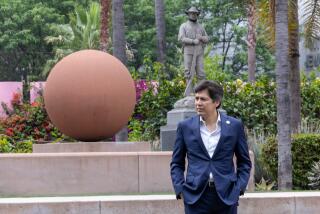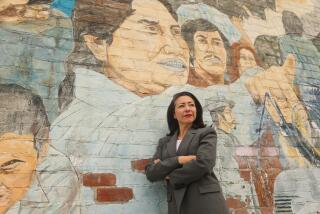In Name-Calling, the Unthinkable Is Always Plausible
Anaheim Mayor Tom Daly didn’t let on he was upset until after everybody was done talking at a recent City Council meeting. Then it was his turn to weigh in on the name-calling.
He didn’t take a stand on the issue raised by several residents that night--the request to rename a planned park after farm labor leader Cesar Chavez. But he wasn’t going to stand for anybody calling him a racist.
Nobody actually did, if you listen to the tape of the Aug. 29 meeting. But one woman came close. She’s a member of Solevar, a community group that has been pushing for the new park in a Latino neighborhood along the Santa Ana Freeway, one exit north of Disneyland.
Poking her pen on the podium like a scolding schoolmarm, she said the city’s handling of the park issue was “race-based . . . discrimination in its most blatant form.” And as for changing the name to Chavez, “we’ve heard every excuse in the book.”
The mayor called the woman’s allegations “highly offensive and flat-out wrong.” Anaheim is not a racist town, Daly seethed. Besides, he added, the city already has two parks named after prominent Latinos. There’s Juarez Park, named after the 19th century Mexican president. And there’s Yorba Regional Park, the largest in the city, honoring “the wonderful Yorba family [which is] still active in our community.”
There’s actually three, counting Peralta Canyon Park. But for Daly, the two were enough to dismiss “this business of somehow Anaheim not being inclusive, and so forth.” And as for “this throwing tantrums if we don’t get our way in a park naming, (that’s) really kind of embarrassing,” he added.
At that point, a woman in the audience can be heard shouting even angrier accusations about alleged white supremacy. The mayor requested that police restore order.
What’s in a name, you ask?
In civic life, naming public places after famous people is the most common form of tribute. It’s perhaps the only form left in Southern California, so bereft of statues and monuments that fame earns you a gold star on a grimy sidewalk.
But picking names is the perk of the privileged. Even in a democracy, the chance to christen things falls to people with wealth and power. In the late 1800s, a man named John Rea bought a 120-acre ranch in Anaheim and named it after his two daughters, Kate and Ella.
Presto, Katella Avenue.
Today, it’s corporate money that buys names. L.A. has a new downtown arena named after a chain of office supply stores. Anaheim has a baseball stadium named after--eek!--a utility company. Pretty soon, I fear, we’ll all be praying at the Crystal Geyser Cathedral.
Cesar Chavez had no riches nor social status. He died destitute, having spent his life defending the lowliest of workers against the mightiest of agricultural concerns. That’s no way to get your name on things.
Chavez recently had a state holiday declared in his honor. The timing is no accident, coming only after Latinos gained more clout in the California Legislature. The same name game plays out locally. In Santa Ana, schools didn’t get Latino names until Latinos got named to the school board.
In Anaheim, almost half the population is Latino, but there’s not one Latino on the all-white City Council or Parks Commission. So the issue goes beyond symbolic park names; it goes to the heart of political representation.
I wonder why non-Latino politicians don’t promote Latino names for parks and streets, without waiting to be pushed? Mayor Daly didn’t have an answer for that. But he acknowledged that Latinos and all ethnic groups should be officially recognized for their contributions to Anaheim’s history. And he says the city is just completing a “cultural plan” that would do just that.
Meanwhile, Anaheim has a long-standing policy for naming its 43 parks. They either memorialize local figures, like Rudolph Boysen who invented the Boysenberry, or enshrine local plant life, like eucalyptus and manzanita.
Otherwise, parks take the names of adjoining schools. The proposed new park is already being referred to as Ross Park, unofficially, since the site sits across from Betsy Ross School. It would be easier to add the UFW’s black eagle to the Stars and Stripes than have Anaheim spurn America’s flag-weaver for a Mexican-American union flag waver.
Yet, power changes and so do names. There’s no place called Leningrad anymore. Some day, Latinos may vote to change Anaheim’s German-based moniker back to the area’s original Spanish name, Rancho San Juan Cajon de Santa Ana.
It just doesn’t sound right for a baseball team.
*
Agustin Gurza’s column appears Tuesday. Readers can reach Gurza at (714) 966-7712 or [email protected]
More to Read
Sign up for Essential California
The most important California stories and recommendations in your inbox every morning.
You may occasionally receive promotional content from the Los Angeles Times.










